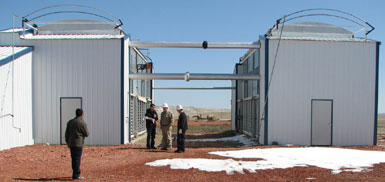The natural gas industry has found a way to increase revenue by making use of one of its waste streams – the huge amount of toxic waste water that’s produced during the fracking process.
Waste water can be used to produce geothermal energy on site and can power equipment used at the oil field, reports Bloomberg.
When oil comes out of a well, so does seven times that amount of boiling waste water. Before the water is pumped back into the well to produce more oil, it can turn electricity-producing turbines, producing geothermal energy.
The idea comes from University of North Dakota researchers who have been exploring how to get geothermal energy from the thousands of fracking wells in the state.
Testing is about to begin. Large pumps will push the hot water through geothermal generators housed in 40-foot long containers. The electricity can either be used on site or sent to the grid, says Bloomberg.

University of North Dakota, Will Gosnold via Bloomberg
The industry uses come 25 billion gallons of water a year in the US, enough to produce geothermal electricity equal to three coal-fired plants.
As you can imagine, with oil at such low prices, new revenue sources are welcome. At the pilot project in North Dakota, each well could bring in another $100,000 a year from a 250 kilowatt geothermal generator, says the Department of Energy.
What About Methane?
The industry can probably make a lot more money, however, by capturing all the methane it releases into the atmosphere.
After carbon, methane is the top greenhouse gas emitted in the US, and the oil and gas sector is a major contributor to both.
Burning the fossil fuels the industry produces is responsible for 77% of US emissions, and gas and oil drilling, processing and transport produces 29% of US methane emissions – the largest source (other major sources are confined cattle operations at 26%, landfills and wastewater treatment plants).
Incredibly, the amount of methane flared into the atmosphere could supply 5 million households with electricity, "packing the same climate punch over the first 20 years as eliminating carbon emissions from more than 160 coal-fired power plants," says Mark Brownstein at the Environmental Defense Fund.
EPA regulations have been in place since 2012 that require leaks to be controlled from drilling wells. That has cut those emissions 9.5%, but the regulations don’t apply to oil drilling or equipment at drill sites.
In January, EPA said its goal is to reduce oil and gas methane emissions 45% by 2025, from 2012 levels. It will propose measures to meet the goal this summer and be finalized in 2016.
Although it’s notable that EPA is targeting the entire system – leaks from wells, pipelines and valves from drilling, production and transportation – rules will only apply to new and modified oil and gas systems – not existing systems – which are currently causing the problem. To handle existing systems, EPA is looking to the industry to take voluntary action.
Worldwide, the amount of methane vented in 2012 could have sold for $30 billion, according to the Rhodium Group, which produced Environmental Defense Fund’s study. If a country produced that much natural gas it would rank #7 in the world, they say.
A 50% cut in oil and gas methane emissions worldwide would be the same as India and the European Union completely eliminating carbon emissions.
The US is giving a $15 million grant to the World Bank to kick-start a "carbon auction facility" – a cap-and-trade program for major methane emitters – factory farms, landfills and waste treatment facilities.
Read our article, Interior Releases Fracking Regulations on Public Lands.
Here’s the Environmental Defense Fund study:
